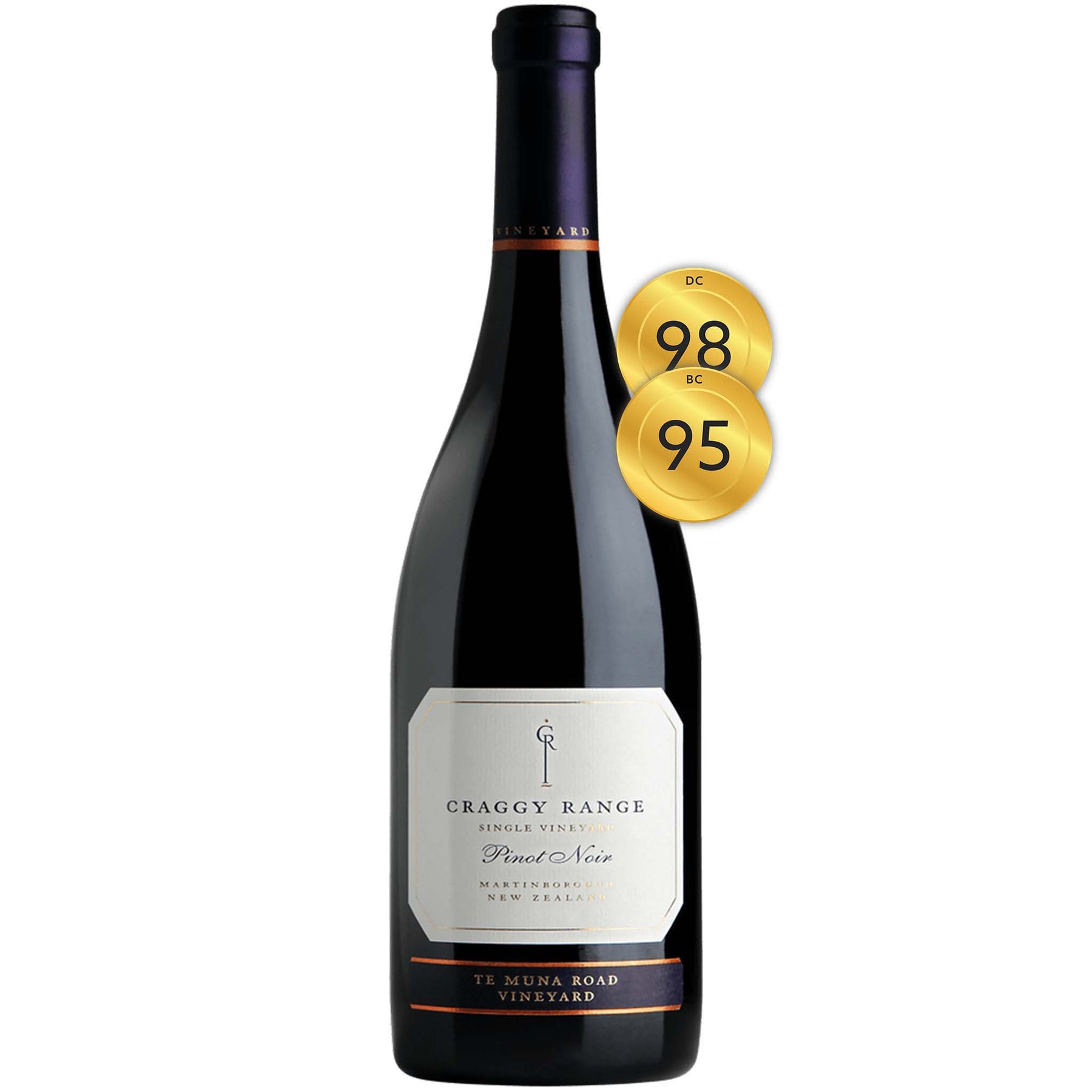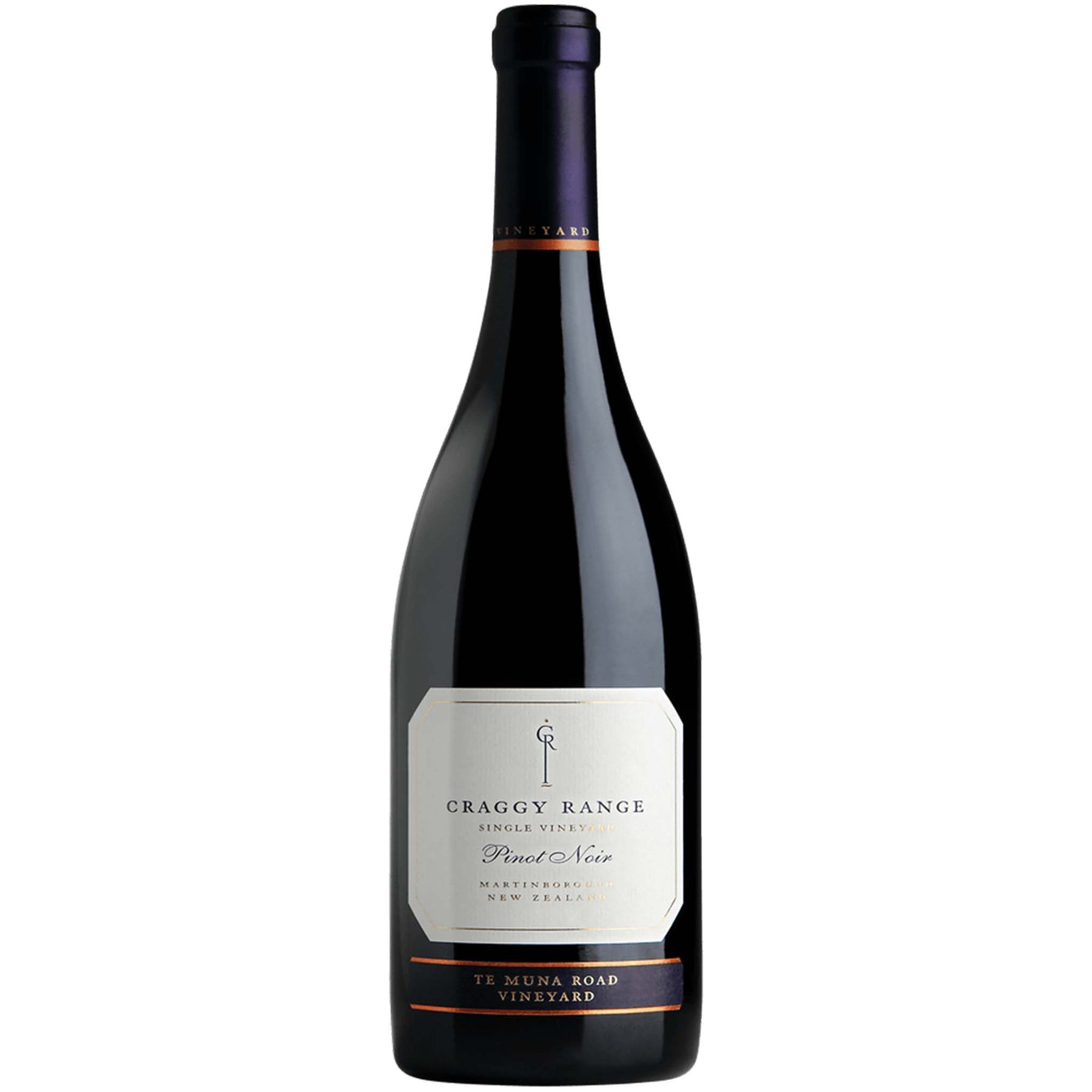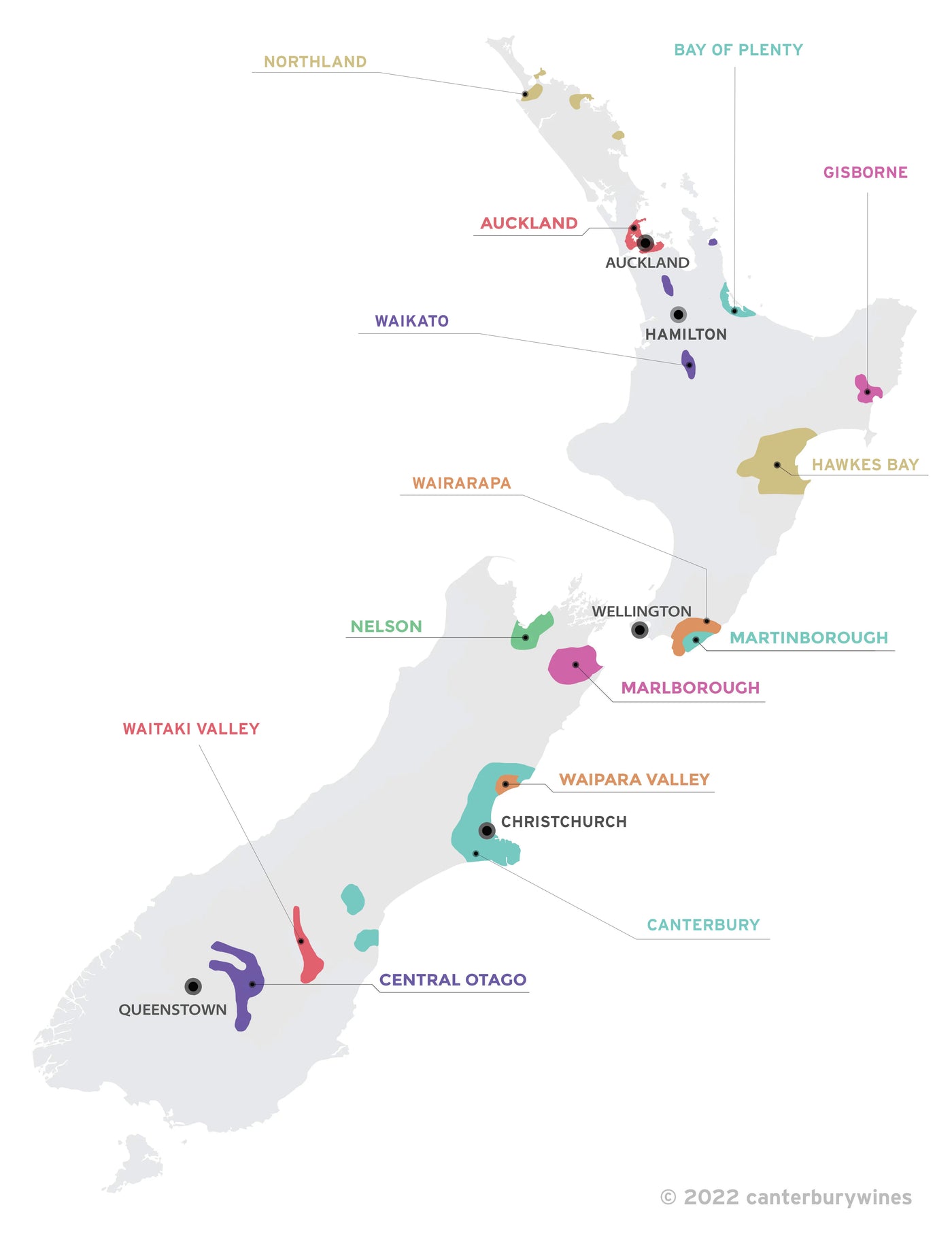

Craggy Range Te Muna Road Vineyard Pinot Noir 2017
Style: Red Wine
Closure: Screwcap
Craggy Range Te Muna Road Vineyard Pinot Noir 2017
Warehouse
34 Redland Drive
Vermont VIC 3133
Australia
Critic Score: 98
Alcohol: 13.0%
Size: 750 ml
Drink by: 2027
The Craggy Range Te Muna Road Vineyard in Martinborough consistently produces a stunning pinot noir with a silky layered texture. The fruit is handpicked from the higher terrace of the Vineyard where the old stony clay soils offer the ideal growing environment for pinot noir. The 81.5 acre terraced Te Muna Road Vineyard is planted with eight clones of Pinot Noir in more than 40 different parcels.
"Fragrant, elegant pinot noir with floral, violet, red rose, dark cherry, plum, anise, spice and classy oak flavours. A wine with power delivered with consummate subtlety. A seductively ethereal texture and lingering finish complete the picture." Bob Campbell MW
"Vibrant red cherry with a crimson hue. Complex aromatic array of dark rose, plum, cherry, tree bark and wooden spices. Supple palate entry with attractive varietal red fruits and lovely tension from the fine tannin profile. A joyful wine full of charm."
Grapes are 100% hand harvested and 85% destemmed before undergoing fermentation with indigenous yeasts in a combination of French oak cuves and open-top stainless steel tanks. The wine matures for 10 months in French oak barriques, 22% new, prior to coarse filtration and bottling." Craggy Range
Craggy Range Te Muna Vineyard
Expert reviews
"Craggy Range Te Muna Road Pinot Noir, Martinborough, 2017 is a dream, I gave this a mark of 98 in a recent tasting of New World Single Vineyard Pinots for Decanter Magazine. The balance between savoury and luscious fruit with perfect acidity, gives a near perfect silky Pinot.” Roger Jones, Decanter Magazine(UK) – 98 points
"Fragrant, elegant pinot noir with floral, violet, red rose, dark cherry, plum, anise, spice and classy oak flavours. A wine with power delivered with consummate subtlety. A seductively ethereal texture and lingering finish complete the picture. Drink: 2020–2025." Bob Campbell MW, The Real Review - 95 points
The vineyards
We took an innovative position of pursuing a multi-regional approach to wine growing meaning we didn't have to compromise. After discovering the promise of New Zealand, the Peabody family decided on the Gimblett Gravels Winegrowing district in Hawke's Bay and Te Muna Road in Martinborough to produce a collection of wines that speak very much of their place.
Gimblett Gravels

A place of warmth and gravelly soils, the Gimblett Gravels Winegrowing District resulted from a flood in 1876 when the Ngaruroro River changed its course and a vista of gravel was left behind. The area is a place of warmth, stone and sandy alluvial soils. This unique combination alongside other climatic factors such as sunshine hours, humidity and rainfall means the gravels retain heat and lead to optimum ripening for Syrah, Merlot and Cabernet. The characteristics of red wines from the vineyard are richness, ripeness and elegance with a distinctive fine dusty tannin finish. Chardonnay is also grown on the vineyard with distinctive floral notes and pronounced minerality on the palate.
Te Muna Road

The Te Muna Road Vineyard is located some 7 kilometres outside of the Martinborough township. The vineyard consists of two distinct terraces, the higher comprising very old, stony clay-infused soils perfect for Pinot Noir. The lower terrace of younger stony soils interleaved with limestone provides an excellent environment for Sauvignon Blanc. The cooler climate of Martinborough ensures the wine is aromatic with steely minerality while the rocky soils give intensity to the fruit. The region's warm, dry summers and mild winters have led to complex and structured wines with subtle aromatics and an elegant finish.
Kidnappers Vineyard

Our Kidnappers Vineyard is located on the Hawke's Bay coastline at Te Awanga where the spring and autumn are warm and sunny and the summer is tempered by the cooling sea breeze. Its ideal location allows the development of intense Chardonnay flavours in the grapes producing a wine with lifted aromatics and a mouth-watering finish.
The craggy range story

When Terry Peabody arrived home from a four-week business trip in the fall of 1993 his wife Mary, and daughter Mary-Jeanne, cooked him dinner. The meal was long and leisurely, but not without purpose. Terry wasn't allowed to leave until he had agreed to go into the wine business. The specification was that the business must never be sold. It was to be a family business, an enduring heritage legacy.
That night, Terry made a commitment to the most important people in his life, and he intended to honour it. The search for a winery began traditionally enough - in France and America, spreading then to Australia. Other business brought him to the edge of the world, to New Zealand: a land of mountains, fire and ice - geographically the youngest country in the world – situated in the sweet latitudes for winegrowing.
'When I pictured a life among the vines, I didn't immediately think of New Zealand, but New Zealand was wonderful because we were interested in clean air, green fields and a culture of care for the land. We didn't want to inherit or extend other people's mistakes.' Mary Peabody
Terry had always been impressed with the quality of New Zealand wines and he sensed a new and exciting possibility. In New Zealand he saw potential he hadn't seen elsewhere. The country's exceptional climate, the youth of the wine industry and the pioneering spirit of the people aligned with his own philosophy and desire to cut a different path. His ambition was not merely to buy into an existing vineyard or to emulate the greatest examples of wine styles in the world - it was bolder. He wanted to create new benchmarks with wines that would become internationally known as the New World classics.
Fate played its part. An acquaintance introduced Terry to noted Kiwi viticulturist Steve Smith, who had been named by Decanter magazine as 'one of the 50 most influential people in the world of wine going into the next millennium.' He was in good company alongside Chateau Margaux's Paul Pontallier, Pierre Henry Gagey of Louis Jadot, and Jancis Robinson MW. He'd just become a Master of Wine - the only specialist viticulturist in the world to have the distinction.
As some collect antiquities or vintage cars, Steve collected land for vintages. A consultant with a rare instinct, and experience in South Africa and Bordeaux, he received more than 350 parcels of wine annually from all over New Zealand. He saw that some pieces of land came through with distinction every time and he'd pinpointed some special places. Gimblett Gravels in Hawke's Bay on the east coast of New Zealand was an area with the perfect growing conditions for his favourite wines – the Bordeaux reds and particularly Syrah. The spectacularly beautiful Tuki Tuki Valley had the soil for Chardonnay and would be the ideal home base from which to build a new kind of winery.
Steve, who always wanted to stretch the boundaries and to whom 'it's nice' would be the ultimate insult about a wine, joined Terry. They made an important decision from the beginning to exclusively pursue the Single Vineyard Philosophy of winemaking – fresh thinking back in 1997. They took an innovative position of pursuing a multi-regional approach to wine growing meaning they didn't have to compromise. After discovering the promise of New Zealand, the Peabody family decided on the Gimblett Gravels Winegrowing district in Hawke's Bay and Te Muna Road in Martinborough to produce a collection of wines that speak very much of their place. Craggy Range was the first in the Southern Hemisphere to adopt making single vineyard wines from multiple regions of the country. Grape was matched to place.
About the winery

Craggy Range is a family-owned winery situated in the shadow of the spectacular Te Mata Peak in the premium wine growing area of Hawke's Bay. It was established in 1998 by Terry Peabody and his wife Mary to create a family legacy, one that could be handed down to future generations. To honour their pledge to the family they established a 1000 year trust, meaning the winery can never be sold.
Their search for a winery began traditionally enough, in France and America then spreading to Australia. An opportunity then brought Terry to New Zealand. Here he saw the potential he hadn't seen elsewhere – the country's exceptional climate, a rich history in farming the land and the pioneering spirit of the people.
It was here that Terry Peabody was introduced to noted Kiwi viticulturist Steve Smith, and together they sought out the best sites in this relatively young country with the ambition of being recognised as one of New Zealand's iconic wine producers. And so they settled on the Gimblett Gravels Winegrowing district, an ancient river bed of the Ngaruroro River in Hawke's Bay. The Gimblett Gravels are the perfect place to grow Syrah, Merlot and Cabernet, as the gravels retain heat which aids ripening.
They then took their search to Martinborough, and more particularly, a spectacular piece of farmland in Te Muna Road. It has two distinct terraces, the higher comprised of very old rocky clay-infused soils that are perfect for growing Pinot Noir. The lower terrace of younger gravelly soils interleaved with limestone allows for a unique style of aromatic, minerally Sauvignon Blanc.
As the vineyards have matured over the years so have the wines. The winery was recognised in 2014 by renowned US publication Wine Enthusiast as ‘New World Winery of the Year'.
The wines of Craggy Range are produced at two sites, the Gimblett Gravels Winery and Giants Winery (refer to the map below). Most of the Craggy Range wines are made at the Gimblett Gravels Winery located in the heart of the Gimblett Gravels Winegrowing district.
The Giants Winery, 25 km away, is at the base of Te Mata Peak in the Hawke's Bay region. The Giants Winery complex and vineyard is home to the Craggy Range cellar door, restaurant and a collection of three cellars. Their flagship wine 'Sophia' is made in one of these cellars, a specially designed circular fermentation cellar containing 8000-litre French oak cuves. Each of the cuves are used for fermenting the Merlot, Cabernet Sauvignon, Cabernet Franc, Malbec and Petit Verdot parcels of wine that come from the Gimblett Gravels Vineyard. Below the Sophia cellar is an underground barrel cellar named The Quarry where the blended components of ‘Sophia' are aged together for its final 12 months. The third cellar is a temperature controlled secondary fermentation cellar.

Craggy Range Wineries and Hawke's Bay sub-regions

New Zealand
New Zealand is home to more than 700 wineries across 14 wine regions. The regions are Auckland, Bay of Plenty, Canterbury, Central Otago, Gisborne, Hawkes Bay, Marlborough, Martinborough*, Nelson, Northland, Waikato, Waipara Valley, Wairarapa and Waitaki Valley. * Martinborough is a sub-region of Wairarapa, however, as it is world renowned it is considered here to be a region to avoid confusion.
The wine regions in New Zealand stretch from latitudes 36°S (Northland) in the north (comparable in latitude to Jerez, Spain), to 45°S (Central Otago) in the south (comparable in latitude to Bordeaux, France). New Zealand's climate is maritime, producing cooler summers and milder winters than would be expected at similar latitudes in Europe.
Viticulture in New Zealand dates back to 1836 when British resident James Busby produced wine in the far north, but it wasn't until 1985 that the wine industry came of age when Cloudy Bay Sauvignon Blanc garnered international attention and critical acclaim.
New Zealand is internationally renowned for Sauvignon Blanc (particularly from Marlborough), Pinot Noir (Central Otago, Martinborough and Waipara Valley), Chardonnay, Bordeaux-style blends of mainly Merlot and Cabernet Sauvignon (Hawkes Bay) and Syrah (Hawkes Bay). Sauvignon Blanc accounts for 63% of the area of the national vineyard, followed by Pinot Noir (14%), Chardonnay (8%), Pinot Gris (7%) and Merlot (3%).

